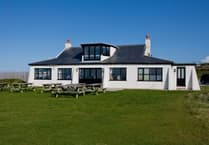Several public bodies have raised concerns about the proposed cannabis cultivation campus on the Cooil Road, saying environmental and infrastructure issues need to be addressed.
Unlike many applications, the Council of Ministers will rule on this application instead of the planning committee.
As widely reported this year, Peel NRE has applied (22/00678/B) to build the campus on land southwest of the Cooil Road and north of New Castletown Road.
The plans for the site, which include a science innovation and research centre (SIRC), sustainable energy park, and a medicinal cannabis cultivation facility, would see 78,000 sq ft of cannabis cultivation space created with around 102,000 sq ft for research and development.
Peel NRE says this could create up to 250 jobs ranging from security to botany and technology.
For this and other reasons, the Department for Enterprise has supported the application as part of the government’s plans to diversify the island’s economy and grow the working population and to introduce more highly skilled jobs.
However, while the DfE has said the scheme ‘has the potential to bring about real and significant long-term economic benefits to the island’, Manx Utilities has raised concerns over the water and electricity needed for the site and the head of the government’s climate change team has objected.
Objections have also been made by Douglas Council and Friends of the Earth Isle of Man.
In the application, Peel NRE has included plans for solar panels which it said would be the island’s only grid-scale renewable project, contributing to the government’s ambitions on climate change.
However, Manx Utilities, in its submissions to the application said that the site has the potential to grow from a requirement of four megawatts to 16MW for phase two.
It said: ‘It should be noted that 16MW is a substantial amount of electricity relative to the Isle of Man electricity network and is equivalent to the summertime electricity usage in the Douglas area.
‘Given the new IoMG target for Manx Utilities to be 100% carbon neutral by 2030, providing this supply capacity may require additional carbon neutral generating infrastructure in the future and potentially a higher interconnector capacity than has currently been planned for.
‘If the site is dependent on the grid for providing back-up power, agreement from the developer that the load may be constrained across high-demand periods and at other times depending on operational requirements may be required.’
The authority added that both phases of the development would require off-site work to install new cables ‘between the site and Pulrose Power Station in addition to localised connections to the existing electricity network in the Cooil Road area’.
Manx Utilities also noted that while the site includes plans for a solar farm, which it says would reach up to 9.2MW capacity, it understands that this is to offset the energy usage within the site and is ‘therefore unlikely energy generated would be exported to other Isle of Man customers’.
If this proves to be the case, then Manx Utilities said the site’s electricity use may need to be limited during peak times, unless it includes the capacity to store power.
Manx Utilities used a separate response to the application to say that ‘it is likely that major reinforcement of the water network will be required to meet increased demands and maintain supplies to existing customers’.
This response also looks at an unconnected plan, 22/00416/B, which is for the development of an industrial and business park, also on Cooil Road.
Manx Utilities said that if both applications go ahead, it is possible that it would need to install a 1km pipe from Cronk Road, Union Mills to Vicarage Road, with that existing infrastructure needing to be upgraded.
It also said it is possible it would need to install ‘a new 1km difficult installation of 180mm HPPE main (water pipe) through the Farm Hill estates’.
It added: ‘It is vital that the “peak” demands for all proposed developments be confirmed and a detailed re-run of the Hydraulic Model is performed before any off-site additional infrastructure works can be accurately assessed and designed.’
Acting in her role as chair of the Climate Change Transformation Board, Garff MHK Daphne Caine has objected to the application, saying the proposals ‘may have serious implications on the island’s ability to fulfil its statutory climate targets’.
These targets are a commitment to net zero by 2050, with a 35% reduction by 2030 and 45% by 2035.
Mrs Caine said: ‘I believe that the mitigation of measures suggested in the proposal does not adequately address the level of carbon equivalent emissions that will be released during the lifetime of the cannabis cultivation campus.
‘It is estimated that the operation of the proposed development in phase one will lead to a ~14,000 t/C02e/yr increase (tonnes of carbon dioxide equivalent per year) and the full development will lead to an increase of between 52,000 - 58,000 t/CO2e/yr.’
Mrs Caine said that the level of consumption ‘represents an approximate increase of between 7.4% - 8.3% in total greenhouse gas emissions in the Isle of Man and is equivalent to the entire 2019 business sector emissions’.
While Manx Utilities has raised concerns rather than objected to the application, the Department of Environment, Food and Agriculture’s Ecosystem Policy Team (EPT) initially went further and said it shouldn’t go ahead.
The EPT said that it doesn’t believe enough information has been supplied with the application to make a full consultation response so it was unable to back the plans.
It said: ‘There are outstanding issues in regards to carbon emissions, water consumption, and site drainage and discharges into the nearby Middle River, all of which could have massively negative biodiversity impacts.
‘These issues need to be investigated in more depth and adequately resolved and/or mitigated before we will remove our objection.’
In a later submission, the EPT said that suitable assessments had been carried out by Manx Wildlife Trust. These assessments looked at bats, birds, and frogs and a preliminary ecological appraisal report, all of which date back to 2020.
Despite this, the EPT said it still had concerns about the implications for the ecology of the Middle River and Middle River Wildlife Site.
It said: ‘We therefore will want to submit further comments once the DEFA environmental protection unit has assessed this application.
‘We would object to this application should modelling show that the development would result in the pollution and reduction in the ecological value of Middle River, without any indication of how these drainage issues would be resolved (e.g. adoption by the MUA) or mitigated.’
The EPT also had concerns about trees that would be removed, disruption to birds and the possibility that a rare grasshopper is breeding on the site, as well as other issues.
However, it did say that ‘we believe that these can be resolved via appropriate conditions of approval’.
Douglas Council has also objected to the proposals, saying that while it welcomed the principle and the potential for development and more jobs, it had concerns that are similar to Manx Utilities.
The local authority also had concerns about the potential costs involved in improving infrastructure around the site.
It said: ‘Unfortunately there is still insufficient information relating to how the existing infrastructure could accommodate water discharge from the development and the effect that this may have on businesses and residents in lower Douglas particularly if there was an increased risk of flooding due to water discharge.’
However, if these concerns could be addressed, the Council said it would likely support the development.




.jpeg?width=209&height=140&crop=209:145,smart&quality=75)
Comments
This article has no comments yet. Be the first to leave a comment.